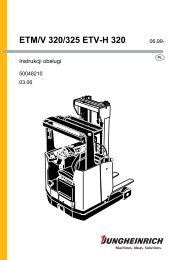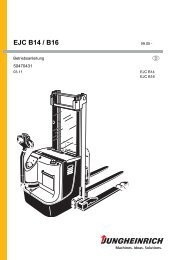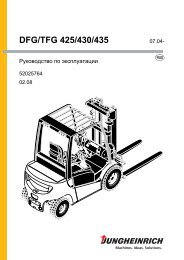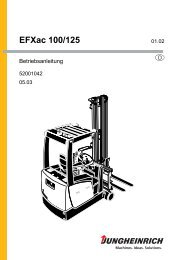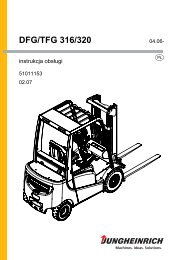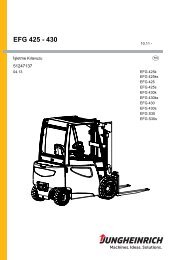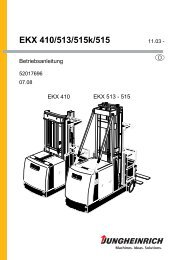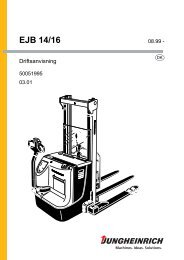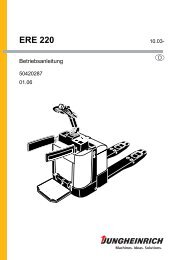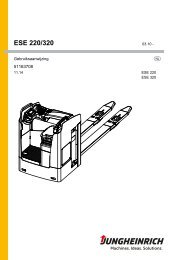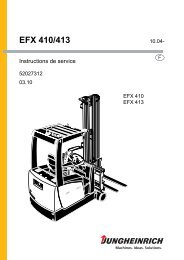Create successful ePaper yourself
Turn your PDF publications into a flip-book with our unique Google optimized e-Paper software.
4 Operation of the fork lift truck4.1 Safety regulations applicable when operating the truckDriving lanes and work areas: Only such lanes and routes that are speciallyallocated for truck traffic must be used. Unauthorized persons must stay away fromwork areas. Loads must only be stored at places specially provided for this purpose.Driving conduct: The travelling speed must be adapted to the prevailing localconditions. The truck must be driven at slow speed when negotiating bends or narrowpassages, when passing through swing doors and at blind spots. The driver mustalways observe an adequate braking distance between the fork lift truck and thevehicle in front and he must be in control of his truck at all times. Sudden stopping(except in emergencies), rapid U-turns and overtaking at dangerous or blind spots isnot permitted. It is forbidden to lean out of or reach beyond the working and operatingarea.Visibility: The driver must look in the direction of travel and must always have a clearview of the route ahead. When loads blocking the view are carried, the fork lift truckmust be driven with the load at the rear. If this is not possible, a second person mustwalk in front of the fork lift truck to give suitable warnings.Negotiating slopes and inclines: Negotiating of slopes and inclines is permittedonly when they are recognised lanes, when they are clean and non-slipping, andwhen the technical specification of the truck permits safe driving on such slopes orinclines. Loads must always be carried at that end of the truck facing uphill. U-turns,cutting obliquely over slopes or inclines and parking of the fork lift truck on slopes orinclines is not permitted. Inclines must only be negotiated at slow speed, with thedriver ready to brake at any moment.Use of lifts and driving on loading platforms: Lifts and loading platforms must onlybe used if they are of adequate load bearing capacity, if suitable for driving on, and ifauthorised by the user of the truck for truck traffic. The fork lift truck driver has tosatisfy himself accordingly before driving into lifts or on to loading platforms. The truckmust enter lifts with the load in front and must take up a position which does not allowit to come into contact with the walls of the lift shaft.Persons riding in the lift together with the fork lift truck must only enter the lift after thefork lift truck has come safely to a standstill, and must leave the lift before the fork lifttruck.Nature of the loads carried: Only loads that have been safely and correctly securedmust be carried. Never transport loads stacked higher than the top of the forkcarriage, or stacked higher than the guard grille.Towing trailers: The maximum trailer load given for the fork lift truck for braked and/or unbraked trailers must not be exceeded. The trailer load must be properly securedand must not exceed the dimensions permitted for the driving routes. After attachingthe trailer but before starting driving, the driver must check that the trailer attachmentis secured against detachment. Towing fork lift trucks must be operated in such amanner that safe driving and braking of the truck and the trailer is guaranteed for alldriving movements.1102.GBE 20



